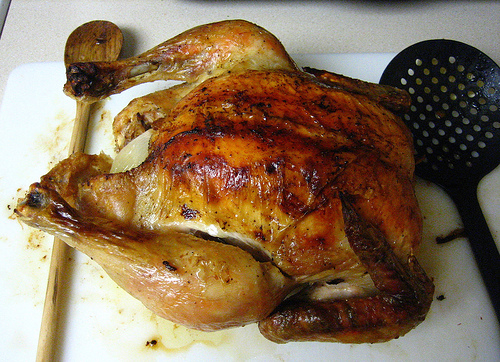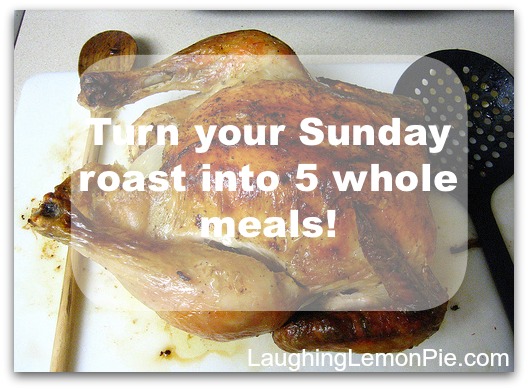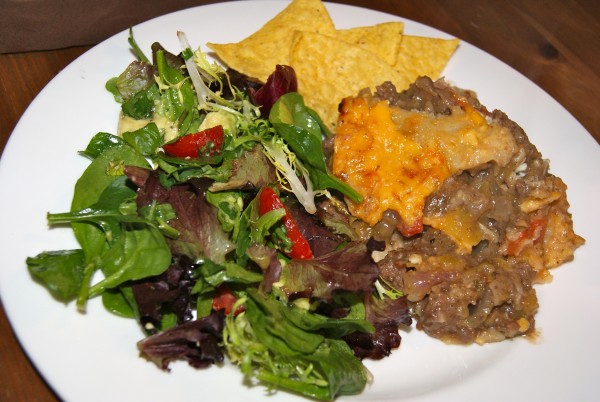One important skill for eating organic on a budget is the ability to buy an inexpensive piece of meat and stretch it for several meals. Likewise, cooking extra vegetables and even starches and grains on days when you have more time, then turning them into effortlessly delicious meals later in the week can help stretch your time and your dollars further.
In that vein, I’m developing several meal plans based on these concepts that will go beautifully with my new ebook, “Budget Cuts: Meal Planning on a Budget,” which will be available for sale February 1!
This is a very Continental style of cooking. In French, they often have le rôti (the roast) on Sunday and, poetically, les restes (literally, the remains or the scraps) for the next meal.
We’ll start with the most ubiquitous and easy to cook of le rôti, a roast chicken.
If you’ve never bought or roasted a whole chicken before, it can look intimidating, but honestly, anyone who can turn on an oven can roast a chicken. Of course, if you’re extremely pressed for time, a rotisserie chicken from your grocery store will do in a pinch, but the point of roasting a whole chicken on our own is that by so doing we can afford a better bird. Buy the best you can afford; pound for pound, whole chickens will almost always be cheapest, but you could also adapt these recipes for use with chicken leg quarters, which can also be very economical.
The size of your chicken will depend on how many people you’re feeding. For two adults and a toddler, I find a three-pound bird is usually sufficient to provide us with at least two, sometimes three meals. For a family of four, shoot for a five-pound bird.
To roast a chicken:
Remove any packaging and any giblets that may have come with your chicken. At this point, you can season it however you like. For the simplest possible seasoning, I like to rub it all over with olive oil (or your favorite oil or butter), and then rub liberally with salt. You can add any herbs you like. In addition, you might throw a quartered lemon, some garlic, or both into the cavity. Feel free to get creative.
Preheat your oven to 375. Figure 20 minutes cooking time per pound, plus an extra 10 minutes. If you’d like your bird to cook faster, you can ask your butcher to butterfly it (or do it yourself with good kitchen shears by simply cutting up the back and removing the spine). Nigella Lawson has a spectacular recipe for butterflied chicken with lemon and rosemary.
If you’re worried about carving, don’t be. It’s easier than you’d think. Google a YouTube video for how to carve a chicken and then allow that you’ll need to practice before it comes out looking perfect. But if you’re cooking for your family, no one will care if it comes out a little wonky the first time.
Roast Chicken Meal Plan
Day 1: Roast chicken with mashed potatoes and vegetables
While your chicken is roasting, boil potatoes for mashing. Make enough for at least two meals (you want to have two cups of mashed potatoes left over). Once potatoes are cooked, drain and mash with salt, pepper, and either butter, cream, sour cream, or some combination thereof until the potatoes reach the desired consistency. Fix one or two additional vegetables to go with; I made carrots cooked on the stovetop with a little butter, white wine vinegar, a pinch of sugar, and dried thyme and some asparagus sprinkled with lemon pepper and broiled right before serving.
Remove all the meat from the bones and store. Then add the carcass to a pot with about 4 cups of water (enough to cover) and throw in a clove of garlic and any vegetable trimmings you have leftover from dinner. Bring to a boil then reduce heat and simmer for an hour. Allow to cool then refrigerate.
Day 2: Bubble and squeak with a fried egg
Slice a Savoy cabbage into thin strips (removing the core and any thick ribs) and wilt in a large frying pan with a little butter or oil and a splash of water. Set aside. Cook one onion, chopped, in additional butter or oil until translucent and add 2 cups of your left over mashed potatoes, seasoning it with salt and pepper. Cook, stirring, until you get some nice browned bits, then mix in the cabbage and 6 ounces of shredded aged cheddar. Once the cheese starts to melt, leave it undisturbed so that you start to get a nice hash brown-style crust on the bottom.
In a separate frying pan, fry up an egg for each person dining. When the eggs are done, serve with the bubble and squeak.
Day 3: Thai green curry with chicken
Cook a pot of rice. In a large frying pan, stir fry a bag of mixed asian vegetables until crisp tender and set aside. Add 1–2 T of Thai green curry paste to the pan and one can of coconut milk (light coconut milk works fine as well if you’re watching your weight) and cook until the mixture begins to simmer. Add 1–2 cups of shredded chicken, a can of sliced water chestnuts (drained), and the cooked vegetables. Heat through. Garnish with basil and lime juice if desired and serve over rice.
Day 4: Tortellini soup
Bring 4 cups of your chicken broth to a boil in a large saucepan and add 1 cup of fresh or dried cheese tortellini. Cook according to package directions. As soon as the tortellini is done, add 1 can of diced tomatoes and one bag (about 3–4 cups) of fresh baby spinach. Heat through and serve with crusty bread and a big salad.
Day 5: Roasted vegetable cobb salad with chicken
On a large serving platter, make a bed of your favorite salad greens. Place any or all of the following in stripes across the top of the greens: shredded chicken (if you have any left), leftover vegetables from day 1, sliced hard boiled eggs, crumbled blue cheese, cherry tomatoes, diced cucumber, shredded cheddar cheese left over from day 2, crumbled cooked bacon, or your favorite salad toppings. Serve with a light vinaigrette and crusty bread, if desired.
image by pinprick







I love this idea I am kinda scared of the whole chicken thing but I am going to try it!
After you do it once, it is not so scary, I promise!!
I really love this idea! Thank You!
You're very welcome!